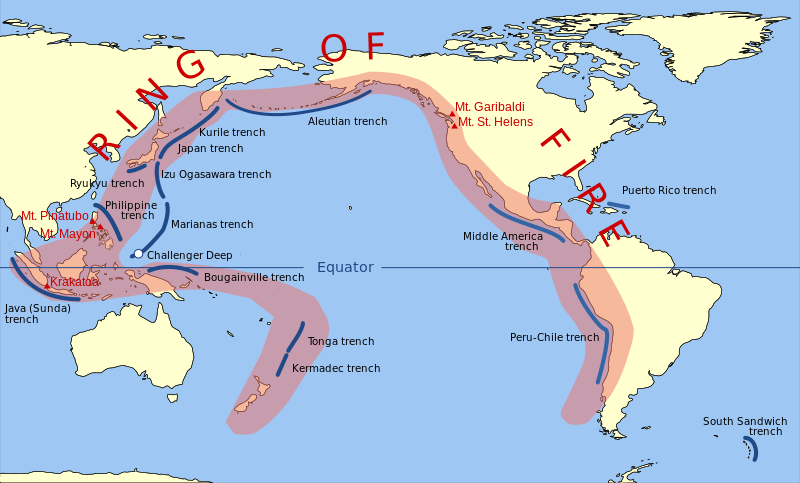The Ring of Fire is an area where a large number of earthquakes and volcanic eruptions occur in the basin of the Pacific Ocean. In a 40,000 km (25,000 mi) horseshoe shape, it is associated with a nearly continuous series of oceanic trenches, volcanic arcs, volcanic belts, and/or plate movements. It has 452 volcanoes and is home to over 75% of the world’s active and dormant volcanoes. It is sometimes called the circum-Pacific belt.

Figure 1. The Pacific Ring of Fire
About 90% of the world’s earthquakes and 81% of the world’s largest earthquakes occur along the Ring of Fire. The next most seismically active region (5–6% of earthquakes and 17% of the world’s largest earthquakes) is the Alpide belt, which extends from Java to Sumatra through the Himalayas, theMediterranean, and out into the Atlantic. The Mid-Atlantic Ridge is the third most prominent earthquake belt.
The Ring of Fire is a direct result of plate tectonics and the movement and collisions of lithospheric plates. The eastern section of the ring is the result of the Nazca Plate and the Cocos Plate being subducted beneath the westward moving South American Plate. The Cocos Plate is being subducted beneath theCaribbean Plate, in Central America. A portion of the Pacific Plate along with the small Juan de Fuca Plate are being subducted beneath the North American Plate. Along the northern portion, the northwestward-moving Pacific plate is being subducted beneath the Aleutian Islands arc. Farther west, the Pacific plate is being subducted along the Kamchatka Peninsula arcs on south past Japan. The southern portion is more complex, with a number of smaller tectonic plates in collision with the Pacific plate from the Mariana Islands, the Philippines,Bougainville, Tonga, and New Zealand; this portion excludes Australia, since it lies in the center of its tectonic plate. Indonesia lies between the Ring of Fire along the northeastern islands adjacent to and including New Guinea and the Alpide belt along the south and west from Sumatra, Java, Bali, Flores, and Timor. The famous and very active San Andreas Fault zone of California is a transform fault which offsets a portion of the East Pacific Rise under southwestern United Statesand Mexico. The motion of the fault generates numerous small earthquakes, at multiple times a day, most of which are too small to be felt. The active Queen Charlotte Fault on the west coast of the Haida Gwaii, British Columbia, Canada, has generated three large earthquakes during the 20th century: a magnitude 7 event in 1929; a magnitude 8.1 in 1949 (Canada’s largest recorded earthquake); and a magnitude 7.4 in 1970.
